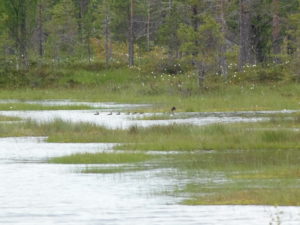
Wetlands provide us with clean water, fish and game, in addition to presenting us with recreational and business opportunities. World Wetlands Day reminds people that the conservation, restoration and maintenance of wetlands are crucial for our well-being.
World Wetlands Day is celebrated in the Nordic countries always on September 2nd. The event, organized by the international RAMSAR Convention on Wetlands, aims to awaken people’s interest in wetlands and remind them of their importance.
Europe’s Waterfowl Multiplying in Finnish Wetlands
In Finland, most of the wetlands are located in agricultural and forestry areas, i.e. outside of the network of protected areas. Due to their large number and size, natural wetlands provide many important ecosystem services. Locally the significance of natural wetlands can be great for waterfowl, supporting the network of valuable bird wetlands.
Finland is the most important producer country when it comes to many waterfowl species in the European Union. Nevertheless, the country’s nesting population has diminished as regards the northern pintail, wigeon, garganey, common pochard, tufted duck and Eurasian coot, all of which enjoy eutrophic waters. According to studies, the primary reason for the decline in their numbers is the deterioration of habitats; eutrophication, overgrowing, the increase in Cyprinidae populations and small predators weaken the nesting success. The tufted duck and common pochard, which often nest in seagull colonies, also suffer from the decrease in black-headed gull populations, whereas the garganey seems to suffer from the dwindling of its favoured water horsetail. Natural wetlands can primarily improve the nesting success of the mallard, teal and common goldeneye, and the best locations also suit more demanding species.
Funding and Collaboration Prerequisites for Wetland Management
The restoration and management of habitats and the intensification of small predator hunting are important waterfowl population management measures. The Finnish Wildlife Agency’s LIFE+ Return of Rural Wetlands project established and restored 47 model wetlands all over Finland and helped in the planning of tens of new wetlands. Throughout history, hunters have built and restored around 2,000 wetlands for waterfowl. From a local point of view, good results are already visible and the work for wetlands is increasingly popular.
The good condition of wetlands and waterfowl populations necessitates collaboration that transcends administrative limitations. Finland’s RAMSAR Wetlands Action Plan, launched in August, presents 55 measures which, when implemented together, can be used to achieve the programme’s vision: “The inland waters, mires and the Baltic Sea, brimming with life, are healthy, maintain diversity, produce benefits and well-being as well as make up an important part of our society.”
Landowners and hunters are the key to the restoration and management of natural wetlands. The main financing methods for wetland management have been the LIFE+ Return of Rural Wetlands project, the agricultural non-production-oriented investment support, and the KEMERA nature management projects. Functional financing channels are the prerequisite for wide-scale management work. For the sake of clean waters, vibrant waterfowl populations and nature’s diversity, the financing mechanisms regarding the cost-effective management of wetland habitats situated in agricultural and forestry areas must be further improved and sufficient funding must be secured.
Read more about wetland management and game husbandry: kosteikko.fi
Read more about the RAMSAR Convention on Wetlands: ramsar.org
Read more about the World Wetlands Day: worldwetlandsday.org
Picture: Mikko Alhainen / Finnish Wildlife Agency
Additional information
Alhainen, Mikko
- Senior Specialist
- International cooperation, projects, subsidies for game habitats
- 029 431 2401
- mikko.alhainen@riista.fi